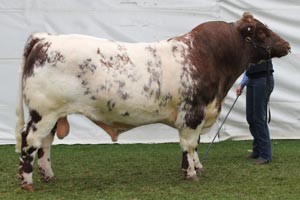You could be forgiven for thinking that the Euro-Star ratings of animals only ever go down. They actually go up as well!
‘Massive fluctuations’, ‘Moving Stars’, ’Sure that bull was bought for 50,000gns, how could his figures drop?’. These are the normal headlines that follow the ICBF Euro-Star system. On reading them you would think that animals figures frequently move ‘all over the place’. Its sensational, travels fast and gets people talking. Unfortunately, the truth is far less exciting.

Table 1 above shows the movement in stars in animals between the May 2015 and August 2017 evaluations. The vast majority of animals Euro-Stars remain stable. Don’t forgot that a single 1 €uro could be the difference between an animal being of a certain star rating and another. As can be seen, only an extremely small number of animal’s ever do the much talked about ‘5 star to 1 star flip’!
It is worth remembering that for some animals whose stars changed dramatically, their parentage would have changed. So instead of being sired by a 5 star bull, the calf has been found through genomics to be sired by a 1 star bull. The farmer would be totally unaware that a different bull got the cow in calf and would have put down the bull that was thought to be the sire. Naturally then the resulting calf starts off with stars that then change depending on what the star ratings of the new correct sire are. As a rule of thumb, 95% of animals move by no more than €25 between runs.
As more progeny performance data, genomic information and foreign data comes into the ICBF database many animal’s Euro-Star ratings increase. This causes a downstream effect in that when a Sire or Dam’s star ratings increase, then the star ratings of their offspring will also get a lift.
Following are examples of AI Sires whose stars increased at the last evaluation run and a brief reason why:




Summary
There is always a reason as to why an animal’s Euro-Stars changed. These reasons can always be found by clicking on the actual trait (shaded in blue) on the ICBF ‘Animal Search’ screen. As can be seen in ‘table 2’ above, the reasons vary from genomics to foreign data to progeny performance. In every case, what is worth remembering is that the ‘reliability %’ figure would have increased. As new information comes in on a bull at each evaluation run, the ‘reliability %’ figure increases, signifying an increasing confidence in what the index is saying about how the bull is breeding.
All of the data used in this article is freely available on the ICBF website. Enter an animal’s tag number into the ‘Animal Search’ and then click on the tabs to find out more about how an animal’s index is calculated.
This article has been prepared by ICBF in good faith on the basis of information provided to it. No representation or warranty expressed or implied is made or given by ICBF as to the accuracy, reliability, completeness of this article. ICBF shall not be liable for any losses (whether direct or indirect), damages, costs or expenses whatsoever, incurred or arising from any use of or reliance on this article or the information contained in it by any person.
